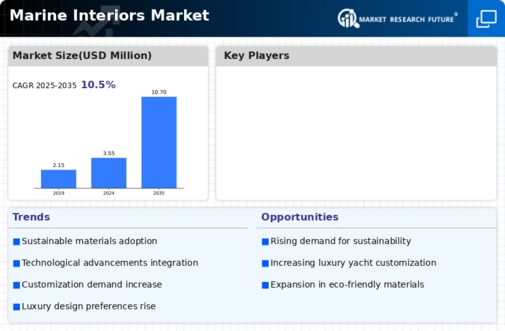Market Trends
Key Emerging Trends in the Marine Interiors Market
Moreover, advanced air filtration and ventilation systems have been specifically engineered to mitigate the air pollution emanating from vessels, such as sulfur dioxide and nitrogen oxides, substances that can pose environmental and human health risks. Simultaneously, environmental regulations are propelling the marine interiors market towards the creation of sophisticated waste management and water treatment systems. These systems are strategically designed to assist vessels in minimizing waste output and treating wastewater before its discharge into the ocean. As environmental standards become more rigorous, marine ship operators are increasingly under pressure to curtail their environmental impact. Consequently, the marine interiors market is poised to witness sustained demand, driven by the imperative to develop sustainable and eco-friendly materials, advanced air filtration and ventilation systems, as well as efficient waste management and water treatment solutions. The burgeoning popularity of cruise ships and other vessels for leisure and vacation travel is contributing to an escalating demand for top-tier, luxurious interior design and amenities. Operators of these vessels are continually exploring novel and inventive approaches to ensure passengers have a memorable and enjoyable onboard experience. This pursuit encompasses the use of high-end materials, distinctive and sophisticated designs, and cutting-edge technology. In addition, substantial investments are made in onboard amenities such as swimming pools, water parks, spas, fitness centers, and high-quality restaurants and bars. These offerings are carefully curated to cater to the diverse interests and preferences of passengers. A recent example of this trend is MSC Cruises' introduction in 2021 of the MSC Starship Club on board the MSC Virtuosa, featuring a humanoid robot bartender and a range of immersive entertainment experiences. ship operators are adapting to the evolving needs of passengers by providing a range of cabin designs and amenities, allowing passengers to choose options such as private balconies, personal butlers, and customized bedding and decor. Consequently, as the maritime tourism industry continues its growth and evolution, there is a foreseen sustained demand for the marine interiors market to innovate in the realms of luxurious interior design solutions, advanced entertainment and recreation facilities, and personalized cabin designs and amenities. This adaptation reflects the industry's commitment to delivering an enhanced and personalized experience, ensuring that maritime tourism remains an attractive and enjoyable option for travelers.




Leave a Comment